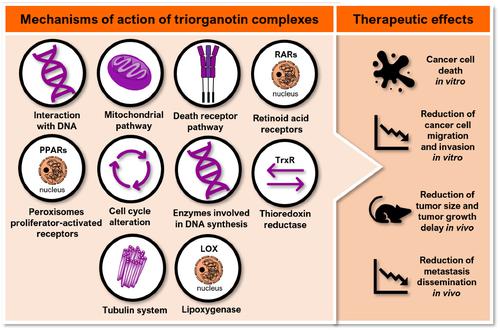当前位置:
X-MOL 学术
›
Appl. Organomet. Chem.
›
论文详情
Our official English website, www.x-mol.net, welcomes your
feedback! (Note: you will need to create a separate account there.)
Triorganotin complexes in cancer chemotherapy: Mechanistic insights and future perspectives
Applied Organometallic Chemistry ( IF 3.7 ) Pub Date : 2020-11-10 , DOI: 10.1002/aoc.6089 Theebaa Anasamy 1 , Chin Fei Chee 2 , Yuen Fei Wong 3 , Choon Han Heh 1 , Lik Voon Kiew 4 , Hong Boon Lee 1, 5 , Lip Yong Chung 1
Applied Organometallic Chemistry ( IF 3.7 ) Pub Date : 2020-11-10 , DOI: 10.1002/aoc.6089 Theebaa Anasamy 1 , Chin Fei Chee 2 , Yuen Fei Wong 3 , Choon Han Heh 1 , Lik Voon Kiew 4 , Hong Boon Lee 1, 5 , Lip Yong Chung 1
Affiliation

|
Current anticancer drug discovery and development efforts are aimed at identifying new complexes that can potently and selectively target DNA and modulate the functions of target proteins. Tin complexes, categorized as monoorganotin (RSnL3), diorganotin (R2SnL2), triorganotin (R3SnL), or tetraorganotin (R4SnL), are one of the most studied complexes in the metal‐based anticancer drug discovery and development field. Among these, diorganotins and triorganotins are widely reported to possess promising anticancer properties, with triorganotins offering several potential advantages over diorganotins, such as a higher total surface area causing higher lipophilicity and hence higher cytotoxicity in cancer cells. However, information on triorganotins' direct therapeutic targets, an in‐depth understanding of their mechanism of action, and useful therapeutic strategies are still lacking. In this review, we discuss the results from in vitro and in vivo mechanistic studies of triorganotin complexes as reported in recent years (2007–2019) and elaborate on the underlying mechanisms that could aid in the identification of triorganotin complex molecular targets. We conclude by identifying present obstacles faced by triorganotin complexes that avert their translation to the clinical phase and current strategies employed to overcome the aforementioned obstacles, and we offer considerations for their future development. These findings are anticipated to stimulate further developments of novel and innovative triorganotin complexes as anticancer drug candidates.
中文翻译:

三有机锡复合物在癌症化疗中的作用:机理的见解和未来展望
当前的抗癌药物发现和开发努力旨在鉴定可以有效和选择性靶向DNA并调节靶蛋白功能的新复合物。锡配合物,分为单有机锡(RSnL 3),二有机锡(R 2 SnL 2),三有机锡(R 3 SnL)或四有机锡(R 4)SnL)是金属基抗癌药物发现和开发领域中研究最多的复合物之一。其中,二有机锡和三有机锡被广泛报道为具有前途的抗癌特性,与二有机锡相比,三有机锡具有许多潜在的优势,例如总表面积更大,导致更高的亲脂性,从而在癌细胞中具有更高的细胞毒性。但是,仍然缺乏有关三有机锡直接治疗靶标的信息,对其作用机理的深入了解以及有用的治疗策略。在这篇综述中,我们讨论了体外和体内的结果最近几年(2007-2019年)报道的三有机锡复合物的机理研究,并详细阐述了有助于识别三有机锡复合物分子靶标的潜在机制。最后,我们确定了三有机锡复合物所面临的阻碍其转化为临床阶段的障碍,以及克服上述障碍所采用的当前策略,并为它们的未来发展提供了考虑因素。预期这些发现将刺激作为抗癌药物候选物的新型和创新性三有机锡复合物的进一步发展。
更新日期:2020-11-10
中文翻译:

三有机锡复合物在癌症化疗中的作用:机理的见解和未来展望
当前的抗癌药物发现和开发努力旨在鉴定可以有效和选择性靶向DNA并调节靶蛋白功能的新复合物。锡配合物,分为单有机锡(RSnL 3),二有机锡(R 2 SnL 2),三有机锡(R 3 SnL)或四有机锡(R 4)SnL)是金属基抗癌药物发现和开发领域中研究最多的复合物之一。其中,二有机锡和三有机锡被广泛报道为具有前途的抗癌特性,与二有机锡相比,三有机锡具有许多潜在的优势,例如总表面积更大,导致更高的亲脂性,从而在癌细胞中具有更高的细胞毒性。但是,仍然缺乏有关三有机锡直接治疗靶标的信息,对其作用机理的深入了解以及有用的治疗策略。在这篇综述中,我们讨论了体外和体内的结果最近几年(2007-2019年)报道的三有机锡复合物的机理研究,并详细阐述了有助于识别三有机锡复合物分子靶标的潜在机制。最后,我们确定了三有机锡复合物所面临的阻碍其转化为临床阶段的障碍,以及克服上述障碍所采用的当前策略,并为它们的未来发展提供了考虑因素。预期这些发现将刺激作为抗癌药物候选物的新型和创新性三有机锡复合物的进一步发展。











































 京公网安备 11010802027423号
京公网安备 11010802027423号